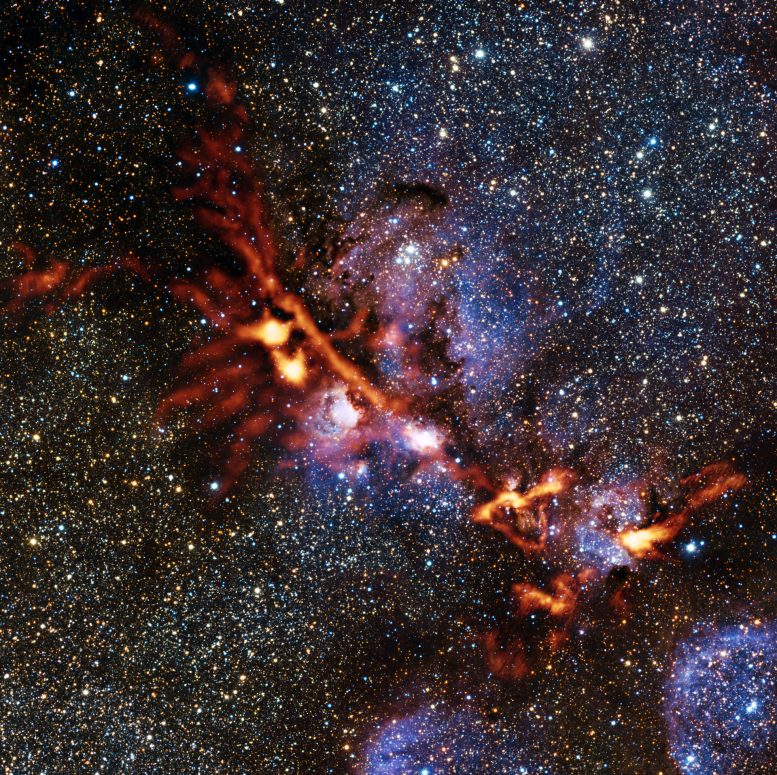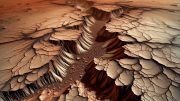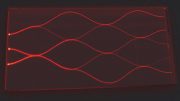
This image of the star formation region NGC 6334 is one of the first scientific images from the ArTeMiS instrument on APEX. The picture shows the glow detected at a wavelength of 0.35 millimeters coming from dense clouds of interstellar dust grains. The new observations from ArTeMiS show up in orange and have been superimposed on a view of the same region taken in near-infrared light by ESO’s VISTA telescope at Paranal. Credit: ArTeMiS team/Ph. André, M. Hennemann, V. Revéret et al./ESO/J. Emerson/VISTA Acknowledgment: Cambridge Astronomical Survey Unit
Engineers have successfully installed an instrument called ArTeMiS on the Atacama Pathfinder Experiment, resulting in significantly better image quality than earlier APEX images of the same region.
A new instrument called ArTeMiS has been successfully installed on APEX — the Atacama Pathfinder Experiment. APEX is a 12-meter diameter telescope located high in the Atacama Desert, which operates at millimeter and submillimeter wavelengths — between infrared light and radio waves in the electromagnetic spectrum — providing a valuable tool for astronomers to peer further into the Universe. The new camera has already delivered a spectacularly detailed view of the Cat’s Paw Nebula.
ArTeMiS [1] is a new wide-field submillimeter-wavelength camera that will be a major addition to APEX’s suite of instruments and further increase the depth and detail that can be observed. The new generation detector array of ArTeMIS acts more like a CCD camera than the previous generation of detectors. This will let wide-field maps of the sky be made faster and with many more pixels.
The commissioning team [2] that installed ArTeMIS had to battle against extreme weather conditions to complete the task. Very heavy snow on the Chajnantor Plateau had almost buried the APEX control building. With help from staff at the ALMA Operations Support Facility and APEX, the team transported the ArTeMiS boxes to the telescope via a makeshift road, avoiding the snowdrifts, and were able to install the instrument, maneuver the cryostat into position, and attach it in its final location.
To test the instrument, the team then had to wait for very dry weather as the submillimeter wavelengths of light that ArTeMiS observes are very strongly absorbed by water vapor in the Earth’s atmosphere. But, when the time came, successful test observations were made. Following the tests and commissioning observations, ArTéMiS has already been used for several scientific projects. One of these targets was the star formation region NGC 6334, (the Cat’s Paw Nebula), in the southern constellation of Scorpius (The Scorpion). This new ArTeMiS image is significantly better than earlier APEX images of the same region.
The testing of ArTeMiS has been completed and the camera will now return to Saclay in France in order to install additional detectors in the instrument. The whole team is already very excited by the results from these initial observations, which are a wonderful reward for many years of hard work and could not have been achieved without the help and support of the APEX staff.
Notes
- ArTeMiS stands for: Architectures de bolomètres pour des Télescopes à grand champ de vue dans le domaine sub-Millimétrique au Sol (Bolometer arrays for wide-field submillimeter ground-based telescopes).
- The commissioning team from CEA consists of Philippe André, Laurent Clerc, Cyrille Delisle, Eric Doumayrou, Didier Dubreuil, Pascal Gallais, Yannick Le Pennec, Michel Lortholary, Jérôme Martignac, Vincent Revéret, Louis Rodriquez, Michel Talvard and François Visticot.








Be the first to comment on "ArTeMiS Improves APEX Image Quality"